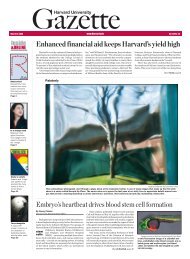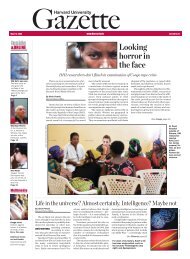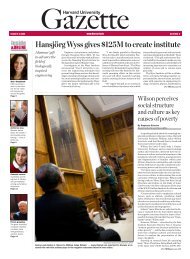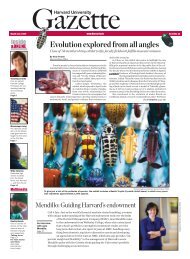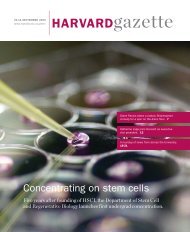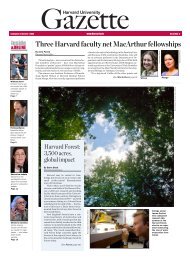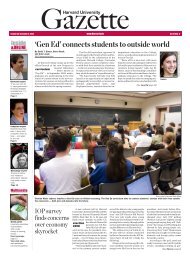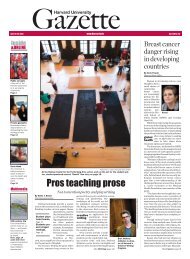8 / <strong>Harvard</strong> University Gazette December 18, 2008-February 4, 2009New ID carddistributionthrough Feb.Continuing through the early winter of2009, <strong>Harvard</strong> is distributing new, hightechnologyID cards to the University community.The <strong>Harvard</strong> ID card is used inmore than 400 systems across campus, andthe new card will make those systems moresecure by segregating key information andencrypting it in card-based technologiesthat are unique to <strong>Harvard</strong>.The new ID card looks virtually identicalto the old card, but it contains new technology,including an embedded microchip,an antenna, and a second (thinner) magneticstripe. All these technologies were selectedto enhance the security of the cardand its associated information, now and inthe future. A University task force of expertsin administration, security, and technologystudied available ID card technologiesand settled on the “HID iClass” card becauseit can hold multiple credentials,process more transactions than other cardtechnologies, and — because of encryption— is very difficult to replicate. In fact, theembedded cryptographic chip is unique tothe University, adding an additional level ofprotection against fraudulent copying.At the distribution points, the ID CardExchange Team will trade affiliates’ old<strong>Harvard</strong> ID card for a new one in a matterof minutes, with all the personal data activatedon the new card.While ID exchange sites and dates werecoordinated to reach the many differentareas of campus, any member of the <strong>Harvard</strong>community can go to any exchange siteconvenient to them to pick up the new ID.Re-carding event scheduleDec. 15-19 (Monday 11 a.m.-6p.m.; Tuesday-Thursday 8 a.m.-6p.m.; Friday 8 a.m.-2 p.m.)<strong>Harvard</strong> Kennedy School, Radcliffe,athletics, A.R.T., Center for Astrophysics,Central Administration,and retirees at the HKS TaubmanRotundaJan. 5-9 (Monday 11 a.m.-8p.m.; Tuesday-Thursday 8 a.m.-8p.m.; Friday 8 a.m.-2 p.m.)<strong>Harvard</strong> Central Administration,Extension School, retirees, athletics,A.R.T., FAS, GSAS, GSD, GGSE,Radcliffe, and HUL at the CambridgeQueen’s Head (Memorial HallBasement)Jan. 12-16 (Monday 11 a.m.-6p.m.; Tuesday-Thursday 8 a.m.-6p.m; Friday 8 a.m.-2 p.m.)<strong>Harvard</strong> Medical School andLongwood hospitals at the HMSNew Research BuildingJan. 20-23 (Tuesday-Thursday 8a.m.-6 p.m.; Friday 8 a.m.-2 p.m.)<strong>Harvard</strong> Business School at theHBS Shad Basketball CourtJan. 26-30 (Monday 11 a.m.-6p.m.; Tuesday-Thursday 8 a.m.-6p.m.; Friday 8 a.m.-2 p.m.)<strong>Harvard</strong> Kennedy School and retireesat the HKS Taubman RotundaFeb. 2-6All remaining at the Holyoke ArcadeFeb. 9-11 (Monday-Wednesday10 a.m.-5:30 p.m.)<strong>Harvard</strong> Law School at the HLSRopes Gray RoomTo be determined<strong>Harvard</strong> School of Public HealthBasketball<strong>Lessig</strong>(Continued from page 1)As faculty director of the center, <strong>Lessig</strong>will expand on the center’s work to encourageteaching and research about ethical issuesin public and professional life. He willalso launch a major five-year project examiningwhat happens when public institutionsdepend on money from sources thatmay be affected by the work of those institutions— for example, medical researchprograms that receive funding from pharmaceuticalcompanies whose drugs they review,or academics whose policy analysesare underwritten by special interest groups.“I am very excited to be returning to<strong>Harvard</strong> to work on a project of enormousimportance to our democracy,” said <strong>Lessig</strong>.“The chance to extend the work of the centerto focus on the problems of institutionalindependence is timely and essential. Iam eager to work with friends and old colleaguesfrom the Law School and across theUniversity to make this project a success.”A prolific writer, <strong>Lessig</strong> is the author offive books: “Remix” (2008), “Code v2”(2007), “Free Culture” (2004), “The Futureof Ideas” (2001), and “Code, and OtherLaws of Cyberspace” (1999). He has publishedmore than 60 scholarly articles inleading law and technology journals. Hiswork also appears regularly in the popularpress, and he was a monthly columnist forWired Magazine.In addition to his teaching, research, andwriting, <strong>Lessig</strong> has also represented clientsCo-captain Emily Tay ’09 became the 13th player in <strong>Harvard</strong> history to score1,000 career points.(Continued from previous page)the second half, playing with fiery aggressionaround the basket (seeming to draw afoul on every possession). The Crimson —which took 25 free throws in the second half— scored 20 of their 36 second-half pointsfrom the line.Freshman standout Brogan Berry led allscorers with a career-high 18 points andwent 12-for-13 from the free-throw line.Katie Rollins ’09 was also impressive,adding 17 points and shooting six for sevenfrom the floor.In the Dec. 14 contest against Maine,<strong>Harvard</strong> came out firing. After shootingone-for-six from the three-point lineagainst Vermont, the Crimson shot the ballwith confidence against Maine, knockingdown eight 3-pointers on 47 percent shooting.<strong>Harvard</strong> also shot 50 percent from thefloor in the game.The first 10 minutes of the game was likea battle of the elements, fire against ice.Maine shot just 26 percent compared withthe Crimson’s 71 percent.Falling behind by as much as 18 in thefirst half, a frustrated Maine team appearedoverwhelmed and overmatched by theCrimson. Yet when a 10-2 run by the Bearscut <strong>Harvard</strong>’s lead to 10, the Crimson increasedtheir level of intensity, ending thehalf with a 41-26 lead.After halftime the Crimson didn’t lookback, as they outscored Maine 32-24.Emma Markley ’11, who went nine-for-16from the floor on the afternoon, finishedthe game with 19 points, 14 rebounds, andthree blocks. On Dec. 15, Markley wasnamed Ivy Player of the Week for the secondtime this season. Also honored by theIvy League was Berry, who was named IvyRookie of the Week for the second consecutiveweek, and the third time this season.Senior guard Emily Tay — who in thesecond half began to score at will — finishedthe day six-for-nine with 14 points, a season-highnine assists, and just one turnoverin the game. She also became the 13th Crimsonplayer to score 1,000 career points. Tayis now 13 points away from Beth Wambach’91, who is 12th place on the all-time scoringlist.in several high-profile cases involving theInternet. He represented Web site operatorEric Eldred in the groundbreaking case Eldredv. Ashcroft, challenging the 1998Sonny Bono Copyright Term ExtensionAct.In 2006, <strong>Lessig</strong> was elected as a fellow ofthe Academy of Arts and Sciences. He is onFor additional information about theEdmond J. Safra Foundation Center,www.ethics.harvard.edu/the board of the Creative Commons project,MAPLight, Free Press, Brave New FilmFoundation, Change Congress, The AmericanAcademy, Berlin, and iCommons.org.He is on the advisory board of the SunlightFoundation and LiveJournal, and has heldboard positions at Public Knowledge(Washington, D.C.), Electronic FrontierFoundation (San Francisco), and RedHatCenter for the Public Domain.<strong>Lessig</strong> was named to the National LawJournal’s “100 Most Influential Lawyers”list in 2000 and in 2006. A past fellow of thecenter himself (1996-97), he has also beena fellow at the Wissenschaftskolleg zuBerlin (1999-2000).He holds a law degree from Yale LawSchool, an M.A. in philosophy from TrinityCollege at Cambridge University, and a B.A.in economics and a B.S. in managementfrom the University of Pennsylvania. Heclerked for Judge Richard Posner of the 7thJon Chase/<strong>Harvard</strong> News OfficeThe Crimson play three more nonconferencematchups — against Siena (Dec. 19),Southern California (Dec. 20), and Northeastern(Dec. 31) — before they open upconference play at home on Jan. 10 againstDartmouth.Circuit Court of Appeals and for AssociateJustice Antonin Scalia of the U.S. SupremeCourt.<strong>Lessig</strong> succeeds Dennis Thompson, theAlfred North Whitehead Professor of PoliticalPhilosophy, as director of the center.Thompson founded the center in 1987 andserved as director until 2007. Arthur Applbaum,professor of ethics and public policy,has served as acting director since thattime. “I would like to extend my heartfeltappreciation to Arthur, under whose leadershipthe center has flourished this pastyear,’’ Hyman said. “We are all most gratefulfor his tremendous stewardship.”“We are deeply proud of the center’sachievements, and we are supremely confidentof its future success under the directionof <strong>Lawrence</strong> <strong>Lessig</strong>,’’ said Lily Safra,chairwoman of the Edmond J. Safra Foundation.“It won’t be easy to fill DennisThompson’s shoes, but we are delighted thatsomeone of Professor <strong>Lessig</strong>’s caliber will bebuilding upon the foundation he laid.”The Edmond J. Safra Foundation is aninternational leader in the support of medicalresearch and health care, education, religion,humanitarianism, and culture. EdmondJ. Safra was a prominent internationalbanker and a dedicated philanthropistwho supported countless humanitarian,religious, educational, and culturalcauses.<strong>Lessig</strong> will join the Law School facultyand take up his duties as director of the centerin the summer of 2009.
By Holly MetterFAS CommunicationsThe world today uses enough power to illuminate150 billion light bulbs for a year.According to some estimates, by 2050, demandwill double, creating irreversible climatechange without reductionsin humanity’scarbon output.Improbably enough, your idle personalcomputer could play a big part in alteringthis outcome: <strong>Harvard</strong> chemist Alán Aspuru-Guzikhas received a multiyear renewablegrant from IBM to harness the powerDecember 18, 2008-February 4, 2009 <strong>Harvard</strong> University Gazette/ 9Idle computing power may ID candidate molecules for efficient solar panelstechnologyof idle desktop computers — a processknown as distributed computing — to developnext-generation solar cells that mighthelp satisfy the world’s future energy needs.“The solution to the energy problem requiresa combination of many different factors,including increasing the energy efficiencyof all activities in our society, dramaticallyramping up the use of all renewableenergy sources, implementing carbonsequestration schemes in our coal plants,and enacting progressive carbon tradingpolicies,” says Aspuru-Guzik, assistant professorof chemistry and chemical biology inthe Faculty of Arts and Sciences, whose researchgroup focuses on the development ofnovel materials for solar cells as a source ofrenewable local power generation.Aspuru-Guzik is among scientists worldwidewho are exploring more efficient waysto convert sunlight into electricity — “aprocess,” he says, “which would likely requireless than 1 percent of the planet’s surfaceto meet that need.”Commercially available solar cells arebased on silicon semiconductor technology.But the specialized manufacturing processis expensive, meaning these cells have not(See IBM, next page)How to get involvedIndividuals can download onto theircomputer a small software program,which, when the computer is not inuse, performs complex calculationsfor a specific World Community Gridproject. To contribute to Aspuru-Guzik’s project, please visitwww.worldcommunitygrid.org todownload the distributed computingclient, and select the Clean EnergyProject.Kris Snibbe/<strong>Harvard</strong> News OfficeDaniel Schrag, director of the <strong>Harvard</strong> University Center for the Environment and professor of earth and planetary sciences,said that most optimistic scenarios of climate change have atmospheric carbon dioxide leveling off at around 500 or 550parts per million — levels roughly double the 280 parts per million that ice cores show existed in preindustrial air.Climate options must include ‘all of the above’Problemimmense,says DanielSchrag, andthere ismuch to bedone — fastBy Alvin Powell<strong>Harvard</strong> News OfficeenvironmentClimate change has so much momentumbehind it that “either/or” discussions aboutoptions are meaningless because it’ll take allwe can do just to arrest carbon dioxide at levelsdouble those in preindustrial times, a topclimate scientist said Dec. 11.Daniel Schrag, director of the <strong>Harvard</strong> UniversityCenter for the Environment and professorof earth and planetarysciences, said thatmost optimistic scenarios of climate changehave atmospheric carbon dioxide leveling off ataround 500 or 550 parts per million — levelsroughly double the 280 parts per million thatice cores show existed in preindustrial air.More pessimistic “business as usual” scenarios,which factor in continued growth in thedeveloping world, show levels as high as 1,000parts per million by the turn of the century.While Schrag said those pessimistic scenarioswould almost certainly mean catastrophicchange, he cautioned that even the most optimisticscenario represents a considerable increasefrom today’s level of almost 390 partsper million.“What people don’t understand is that wewill be at 500 parts per million. The question is:Will we go to 1,000?” Schrag said. “Double thepreindustrial level might be a catastrophe, butit might also be the best we can do.”The potential changes in store includedroughts, floods, stronger storms, and increasedextinctions. Schrag also highlightedthe danger of sea level rise. The dramatic icemelt in recent summers has already mademuch of Russia’s northern coastline and theNorthwest Passage from the Atlantic to the Pacificthrough Canada ice-free for parts of theyear. Though the effects of climate change haveproven difficult to predict, Schrag said, it’s possiblethe Arctic Ocean will become ice-free assoon as a decade from now, far faster than recentpredictions that it would happen by midcentury.Melting Arctic ice has ramifications for peopleliving in coastal locations around the world,he said, since it is Arctic ice that helps keepGreenland’s immense glaciers cool. Greenland’sglaciers contain enough water to raisesea level by 7 meters should they melt or slipinto the sea. Schrag said scientists don’t knowwhether that will happen in 1,000 years, 200years, or even sooner.Schrag spoke at the Geological Lecture Hallin the third talk in the <strong>Harvard</strong> Museum of NaturalHistory’s Earth Matters lecture series. Theevent, “Solving the Climate-Energy Challenge,”featured Schrag and Kelly Gallagher, directorof the Energy Technology InnovationProject at the <strong>Harvard</strong> Kennedy School.The planetary systems — earth, air, andocean — that are affected by rising carbon dioxidelevels are so complex that scientists stilldon’t know how the Earth will respond. We are,in effect, conducting a planetwide experimenton the Earth, Schrag said, the outcome of whichis uncertain.“What we don’t know is very likely going tohurt us,” Schrag said.Another potential problem is that mountainsnowpacks are melting. Mountain snow andglaciers, refreshed each winter during coolertimes, have been shrinking, threatening areasthat rely on snowmelt-fed rivers, such as largeparts of the American West. One projectionshowed melting beginning weeks, even months,earlier, raising the possibility that snowmeltwill dry up by the middle of summer, leavingcrops to whither.“If that water runs out by July, agriculturein California is gone,” Schrag said.Major rivers of Asia on which millions ofpeople depend, such as the Indus, the Ganges,the Mekong, the Yellow, and the Yangtze, alldraw some of their flow from melting mountainice and snow, raising the specter of water(See Climate, next page)
- Page 1 and 2: 36/ Harvard University Gazette Dece
- Page 3 and 4: December 18, 2008-February 4, 2009
- Page 5 and 6: December 18, 2008-February 4, 2009
- Page 7: December 18, 2008-February 4, 2009
- Page 11 and 12: December 18, 2008-February 4, 2009
- Page 13 and 14: Fair shows progress of humanities i
- Page 15 and 16: By Emily T. SimonFAS Communications
- Page 17: 60HarvardcelebratesThe UniversalDec
- Page 20 and 21: December 18, 2008-February 4, 2009
- Page 22 and 23: Upon the recommendation of the dean
- Page 24 and 25: December 18, 2008-February 4, 2009
- Page 26 and 27: December 18, 2008-February 4, 2009
- Page 28 and 29: December 18, 2008-February 4, 2009
- Page 30 and 31: December 18, 2008-February 4, 2009
- Page 32 and 33: December 18, 2008-February 4, 2009
- Page 34: Antarctica(Continued from page 1)Su



